The post Impact of the Coronavirus on the Technology Industry appeared first on The Digital Journal.
]]>Working remotely has been around for many years and the new ways of working has been consistently changing the organisational construct to enable people to work via mobile devices, VPN’s and remote workstations. Collaboration via digital technologies has been increasing exponentially with each new feature as people even in the same workspace share information, knowledge and plans in their digital workspace.
With key messages from world health leaders to drastically reduce populated areas, students are moving even further into distance learning, with the added pressure of the government bans on travellers from overseas, international students are unable to attend universities effectively hitting one of the most profitable areas of the educational sector. Particularly in countries like Australia where students come to study at some of our nations top institutions.
Educational institutions have been forced to accelerate their online learning programs, even if for the first of the years semester in order that students are able to commence their studies and attend later. It makes sense that educational organisations that have already invested in online learning have a head start but there is no doubt that online study is going to change even more than it has already.
Similarly, businesses small and large are sending staff home to work at a moments notice if there is even a hint of exposure to staff with COVID-19 like symptoms. In many cases, these are organisations that have never had to provide ‘work from home’ facilities before and may not be used to implementing such practices. While the premise might seem simple enough, take your laptop and access your apps and email from home as long as you have an internet connection. The reality is that as an organisation, leaders may not yet be accustomed to working with staff who are not onsite. Discussions, scrums, team meetings and the like which would have been the norm are not occurring in the same manner and require a digital approach (Facetime, Skype, Google Hangouts etc) and this is a change in how they do things. Monitoring work productivity is often needed to be addressed as inevitably there are those that work really well offsite and those that seem to get distracted.
Technology support areas of the business seem to have been inundated with new requests for security changes, VPN’s access through firewalls and the provision of applications and services via remote locations. Moving key applications if not all, to the cloud for greater accessibility and ensuring that they are all available outside the network. This brings about a whole new raft of security needs that should be addressed in order for this to take place. Protection of data, monitoring of services and the use of tools remotely – including internet speeds required for some of the modern applications through remote desktops and even the prioritisation of staff, who gets support first and who gets the most attention. These present a range of new issues and urgency for tech support staff as new and innovative ways of addressing these problems are required.
The impact of work from home on the business culture cannot be missed either. Studies have demonstrated the benefits of inter-office relationships, the sharing of information and the organisational culture when working onsite being a huge part of what makes the organisation successful. As an example, imagine working at Google Headquarters and being told to work from home instead? While there are many that enjoy working from home, there are equal studies where people start to feel isolated and no longer part of the organisation and this change needs to be addressed for the organisational workforce to remain productive. At the other end of the spectrum, the staff that have been sent to work from home may not want to return and work in the office anymore.
Most organisations were already looking at such changes and the challenges that they represent, this is not really the issue. What the current COVID-19 has presented however, is the need to address such challenges more rapidly and with greater flexibility. Leaders will no doubt be thinking about such approaches in the coming months and seeking a response from technology leaders, not just to address the current state, but also how to prepare for an event such as this in the future. If they are not, then it certainly needs to be on the technology roadmap.
The post Impact of the Coronavirus on the Technology Industry appeared first on The Digital Journal.
]]>The post Digital Transformation and Technology appeared first on The Digital Journal.
]]>The Wall Street Journal recently published an article declaring that directors and executives believe the business environment will be faced with even greater challenges in the coming year, particularly around Digital Transformation. Organisations that have been around for many years have become the digital laggards and are finding it increasingly difficult to transform or become like those that are born in the digital age and taking advantage of digital technologies that are available and are instead grappling with old legacy systems. Similarly, Forbes also recently stated that 70% of all digital technology initiatives do not reach their goals. Both articles however contained similar reasons for the challenges and failures organisations face, noting that while transformations often do not achieve their goals, the key reasons for this are that digital transformation often forgets that it is about people, not the technology.
Enterprisers Project claim three reasons that digital transformations fail which include:
- Lack of up front commitment, either unwilling to continue the success from the first phase or unwilling to continue to push the organisation further along the path from fear of resistance.
- Failing to take the iterative approach, which often results in a long-term project resulting in the organisation suffering fatigue before achieving results.
- Putting technology at the forefront, which often leaves out the user experience and fails to bring people along for the journey.
HBR offers two reasons for the failure of digital transformation projects which include the unspoken disagreement among the executive resulting in them being not aligned. With the misalignment of the goals, the digital transformation project ultimately fails, while the second reason proffered is the disparate capabilities between the ability to launch a pilot, which is often a success and requires a much smaller commitment than the much larger enterprise approach when scaled up.
A look from another angle finds that there are many approaches to be able to do digital transformation correctly, interestingly the same sources writing about the failures also have gathered insights into that which is needed for their success. Forbes for example discusses the digital transformation failure of many organisations with Michael Gale from PulsePoint group who claimed:
“One of the most basic impediment to moving forward on the road to digital transformation is whether or not enough people within the organization are aware of the challenges. Because if they’re not aware of the challenges the probable truth becomes they’re either going to trip up, fall over and be massively disappointed when it comes to doing it. Basic awareness about those challenges is probably the key indication of how well the process will be successful.

Its quite clear when addressing both the reasons for failure and the bricks of success and that is people. A review of as many failures and successes as you can find and that one constant becomes apparent and that is people. Getting the people component right is the key ingredient and fail that, then digital transformation is just not going to work. Enterprisers Project even outlines four different types:
- Connectors who are those people that can make the right connections across the organisation
- Challengers who constantly seek question, raise and offer suggestions of continuous improvement (these are the people that often say ‘why dont we do this instead’.
- Agilists who adapts to the changes and help to move in the new directions that are required to take advantage of the changes in technology and processes.
- Navigators help the organisation by being constantly aware of the next technology trend and drive towards that next great change.
Finally, as with any technology project, the people need to be brought along for the ride. Its not about the technology, and if the transformation is made about the technology it will fail.
The post Digital Transformation and Technology appeared first on The Digital Journal.
]]>The post 2016 Internet Trends and Mary Meeker appeared first on The Digital Journal.
]]>Her full report is included below, however, some of the key points have been extracted here for discussion.
Global internet adoption rate has flattened for the second year in a row at 9%. This is still a sizeable rate on a truly massive number, but the stellar growth is starting to slow down largely because unless babies are going to start being born with an iPhone (and Apple is likely working on that), then just about everyone who possibly can have some connectivity to the internet already has. Which highlights some of the third world issue, but that is part of a different study. In Australia, Internet connectivity hovers around 93% of the population have it, the rest are babies.
With the speed of the internet increasing all the time, 4G becoming ubiquitous then video is exploding led by Snapchat, Facebook live streaming and YouTube, all of which have made it easy to share video now. Although not mentioned, devices with HD capabilities are more prevalent and this is enabling anyone with a smartphone the capability to create videos and share them on smartphones. Live video streaming of users content is delivering phenomenal growth as videos such as Candace Payne’s Chewbacca Mask on Facebook live reaches 153 million views in a matter of days.
Streaming is becoming largely the norm as online video sites such as Netflix begin to dominate people’s viewing choices in what sounds like the death knoll for traditional free to air channels and the advertising revenues that they represent.
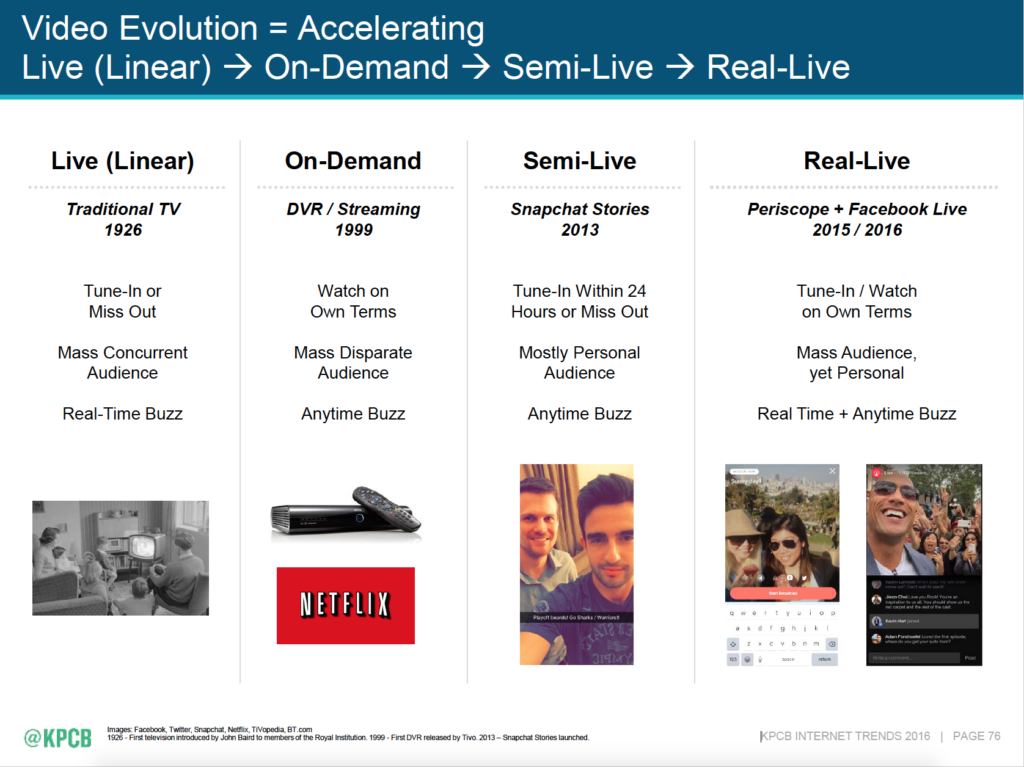
Video is evolving to combine the control of video on-demand and direct communication to mass audiences and live broadcasts
People are still sharing images and this is still the strongest (for the time being) and this is lead by SnapChat. Users are building their own new revenue streams on apps like SnapChat and Instagram where those with a large following and a specific niche are being offered money to promote a good or service.
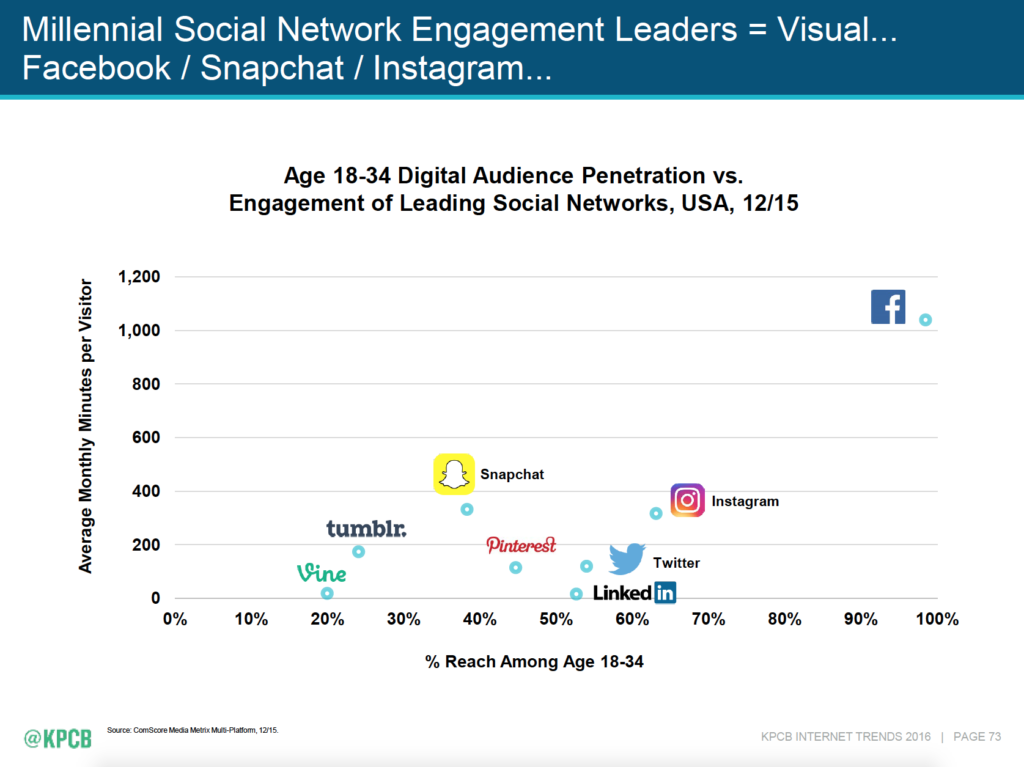
Social Network Engagement
Messaging is dominated by Facebook and WeChat (for China) and this is growing rapidly with apps like WhatsApp which have made Comms giants like Telstra and Optus lose out big on text messaging.
A huge prediction is being observed by Mary Meeker in the rise of voice search, with Google noting that more than 20% of searches are no longer text based.Google and Facebook now control about 76% of the advertising market, but its also clear that there is still too much being spent on legacy advertising for far less effect. There is a clear advantage for the early adopters to move into the digital advertising space, gaining the first mover advantage. In addition to this, there is further opportunity for mobile advertising with desktop ad-blocking up by 96% and this is led by China and India. Advertisers need to make their advertising more entertaining and less intrusive or risk offending their audience.
The United States being the once giant of the auto industry is set to possibly make a resurgence in the innovation with Tesla, Google and Apple all working heavily on telematics and vehicular automation and their homegrown business for car-sharing/pooling Uber and Uberpool being set to becomg a booming global business. With the emergence of voice as a more dependable interface lead by Apple Siri and Android’s offering, the combination of these in to cars will certainly become a more used method of controlling devices while driving. See our Chandler, Arizona, limousine service right here. that uses this feature which is being enjoyed by all the clients after using them.
Generational group Millennials are no longer just an age group, they are a force with a unique set of values and with a bigger focus on work-life balance, self-development and community contribution. Their purchasing power is set to become a major force with most of them expecting to be millionaires earlier in their lives and less interested in property ownership.
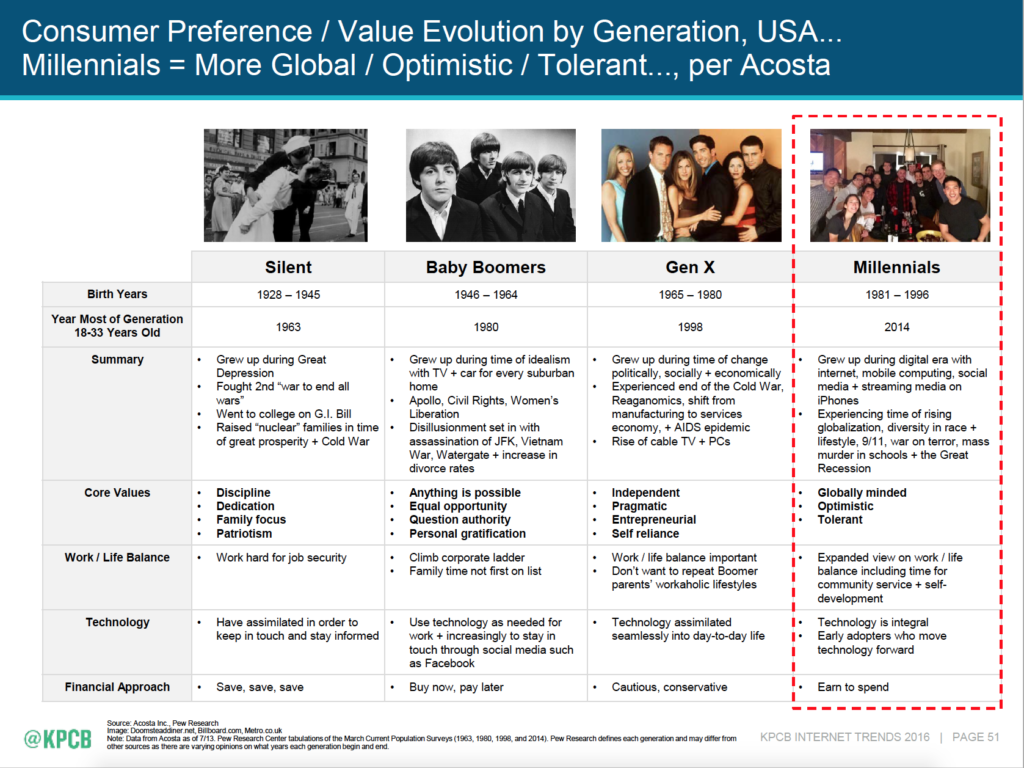
Consumer preference/value evolution by generation. Millenials more global, optimistic and tolerant.
The emerging Generation z cares more aboutuser experience, ease, personalisation and aligned values when compared to millenials who focus on price and comprehensiveness. This is a major insight for organisations wanting to target these markets are are spending up on UX design. While there is clearly a place for the money being spent on UX, other research suggesting people to be careful are indeed correct when stating that it is potentially at the expense of other market segments.
The internet enabled physical brands is again on the rise with Apple being named the most successful combination. Australian stores such as JB HiFi are really taking these combinations to the next level leaving a clear opportunity for stores like Myer and David Jones if they can develop their omni-channel approach.
Non-tech companies have changed their tech investment strategies by purchasing tech companies as a means to accelerate their technology innovation. Particularly the big consulting companies and investment bankers who have invested in data mining companies, analytics and cloud applications as a means to facilitate their plans to supply a range of services to businesses.
As devices to generate data are increasing rapidly (Apple TV, gaming devices, mobile computers fitbits, social applications and cars themselves) the third wave of data management is becoming even a bigger one that the previous. Data is becoming more powerful than ever and the new tools are giving more people in organisations the ability to make data driven decisions. Cloud platforms such as Salesforce are very quickly moving these activities from the CIO’s office and into the business. CIO’s must either become the enablers of this and facilitate, or the business, armed with a credit car will be able to do it themselves. Applications such as SalesforceIQ are user friendly, easy to set up and deliver major results in analytics to place businesses way ahead in this part of the game but they are not without their challengers such as DataDog which is a cheaper alternative, easier again but of course not as configurable, it does nevertheless provide a leapfrog approach for the business that wants to get in and get started quickly.

Evolution of the data platform
Data security using network incident detection tools was also earmarked as a major focus as businesses start to operationalise their API’s and make them available for partners and customers. With the ‘opening of the gates’, it becomes imperative that businesses lock down their security or risk bigger problems.
There is a stack of data in the presentation which will help any business cases in technology and they are well sourced. It pays to have a good read through and if you find other insights I missed, please leave a comment.
The post 2016 Internet Trends and Mary Meeker appeared first on The Digital Journal.
]]>The post Cloudflare – Boosting site performance with Cloud CDN appeared first on The Digital Journal.
]]>The Problem – slow site performance
For some time now, our corporate site has suffered some severe performance issues. Not just ordinary performance, we are talking a download time of around 60 seconds for just the homepage. Now while there are some other issues that include some coding, scripting and technical aspects which need to be addressed, there is also a further matter of the web content publishers that use the Content Management System. Both of these have adversely impacted the sites performance, and many times there has been a lot of blame placed upon the CMS itself from being too difficult to use, not intuitive and complicated but really it was about training. The practice of a more rigorous code review process also contributed to the matter, which is being addressed as well. Ultimately, a quick fix appeared to be the potential for a CDN to speed up the delivery of content.
What is a CDN?
A Cloud Delivery Network (CDN) is a system of servers around the world that are connected and that host your content for you. Its a way of providing alternative sources of distributing the content to users from various alternative high speed delivery servers. Mostly from a server that is closer to the user which adds to the speed of delivering the content. The CDN will make copies of the site and the site content and when a user requests content that is part of the CDN, the network will redirec the request to communicate with the cached content. The process is virtually transparent to the end user except for the speed of delivery which should become noticably faster.
There are a lot of CDN’s around these days, from from the very high end providers such as Akamai to the lower end ones, which have proven to be quite successful. In this case, at least for trials, we chose CloudFlare.com which gives a fantastic business account for just $200 per month. They offer some great free accounts as well for those of us who are simply blogging, but ultimately, this provided the best deal to go for some trials, get some stats and see what the difference was.
Watch the Video
Installing Cloudflare
On your simple website, the installation is a very simple process. By entering the URL of the site you want to add, simply click the Add Website button and the CloudFlare wizard will take over the rest searching the server for the various records that it will use to collect the appropriate content. When the records have been scanned, the wizard will ask you to continue.
When the records have been scanned, the wizard will ask you to continue.
 The wizard will present the user with the DNS records to be configured, this is not too daunting a task as there is already a recommended configuration provided. The real options are to choose what goes through the cloud network, versus what will bypass the cloud. For the more advanced, a zone file can be uploaded with a set of preconfigured records.
The wizard will present the user with the DNS records to be configured, this is not too daunting a task as there is already a recommended configuration provided. The real options are to choose what goes through the cloud network, versus what will bypass the cloud. For the more advanced, a zone file can be uploaded with a set of preconfigured records.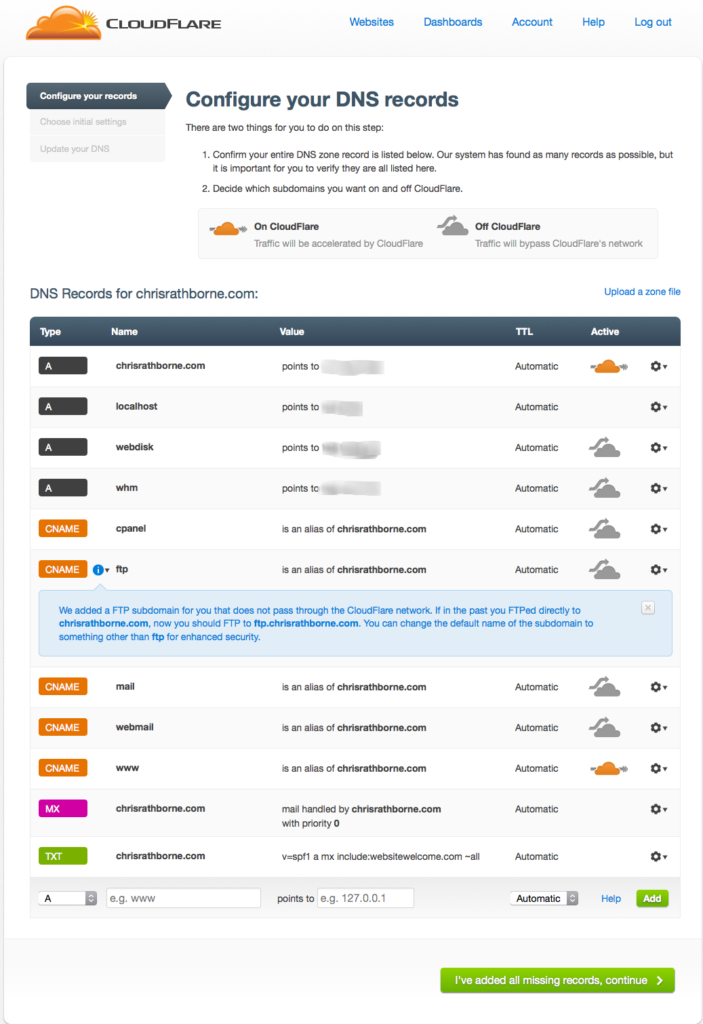 The final option is to set your plan and the configurations that are desired. For this site, I chose the free option and the full optimisation, whcih basically means that as much content as possible will be sent to the cloud. Security settings are something additional, and you can limit the countries that are accessing your website. Its easy enough to move to the business account which offers more support and some other options, but again, for this example the free option was selected.
The final option is to set your plan and the configurations that are desired. For this site, I chose the free option and the full optimisation, whcih basically means that as much content as possible will be sent to the cloud. Security settings are something additional, and you can limit the countries that are accessing your website. Its easy enough to move to the business account which offers more support and some other options, but again, for this example the free option was selected.
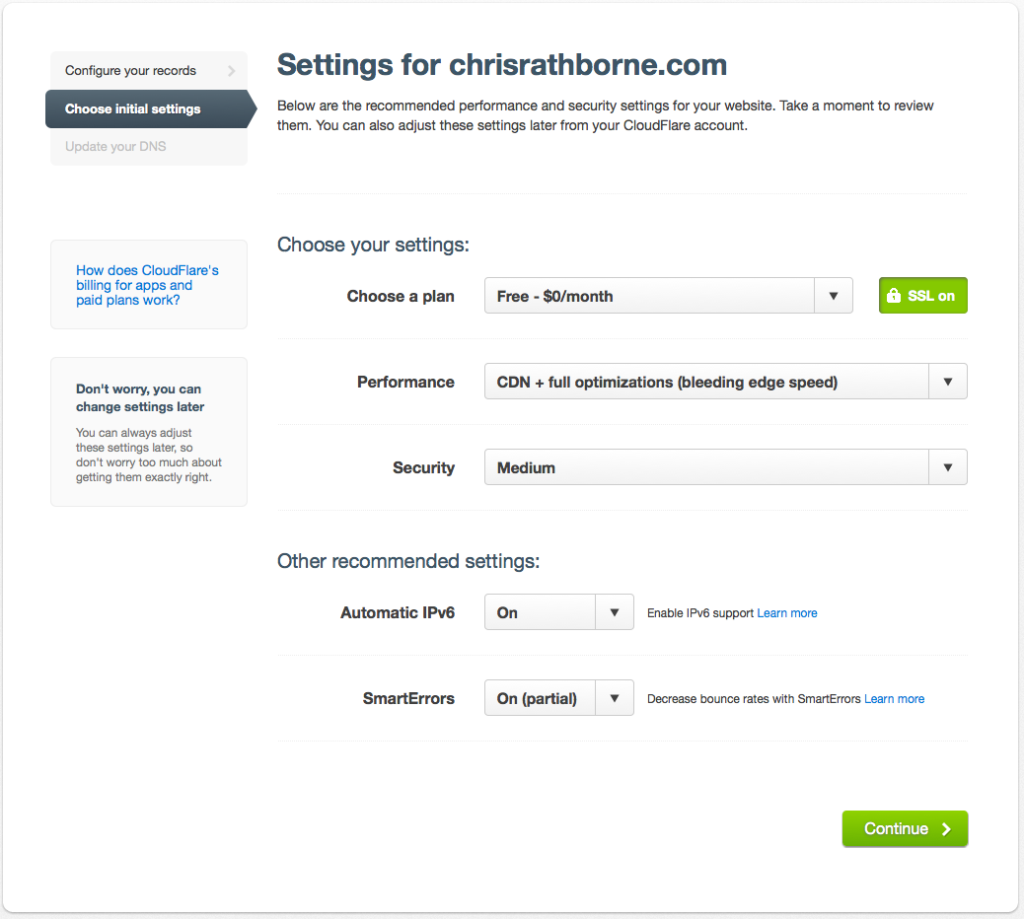 The final setting is to change your nameservers to redirect them from their current position to the cloudflare network. This is doen through the host of your nameserver (the company that hosts your internet address). This tells the traffic to be routed through the CloudFlare network rather than direct to your site host server.
The final setting is to change your nameservers to redirect them from their current position to the cloudflare network. This is doen through the host of your nameserver (the company that hosts your internet address). This tells the traffic to be routed through the CloudFlare network rather than direct to your site host server.
Using a CNAME setup
One difference we had was to use the CNAME setup. This allowed us to modify our CNAME record to direct the traffic to the CloudFlare server rather than change the nsameservers. A key difference (and benefit), apart from the instant change, was that if we wanted to change the records back, we could change the CNAME record back and we would have instant roll-back. When changing NameServers, there can be a lag in the update of up to 48 hours and this method made the changes instant. This option was only available under the business account with CloudFlare.
Results
Overall, performance has improved impressively. The trial site we have implemented so far moved from around 27 seconds to load to less than 7 seconds. The final screenshot below indicates the performance of this site alone. The CloudFlare network has quite a few benefits, this is the free account and the performance speaks for itself.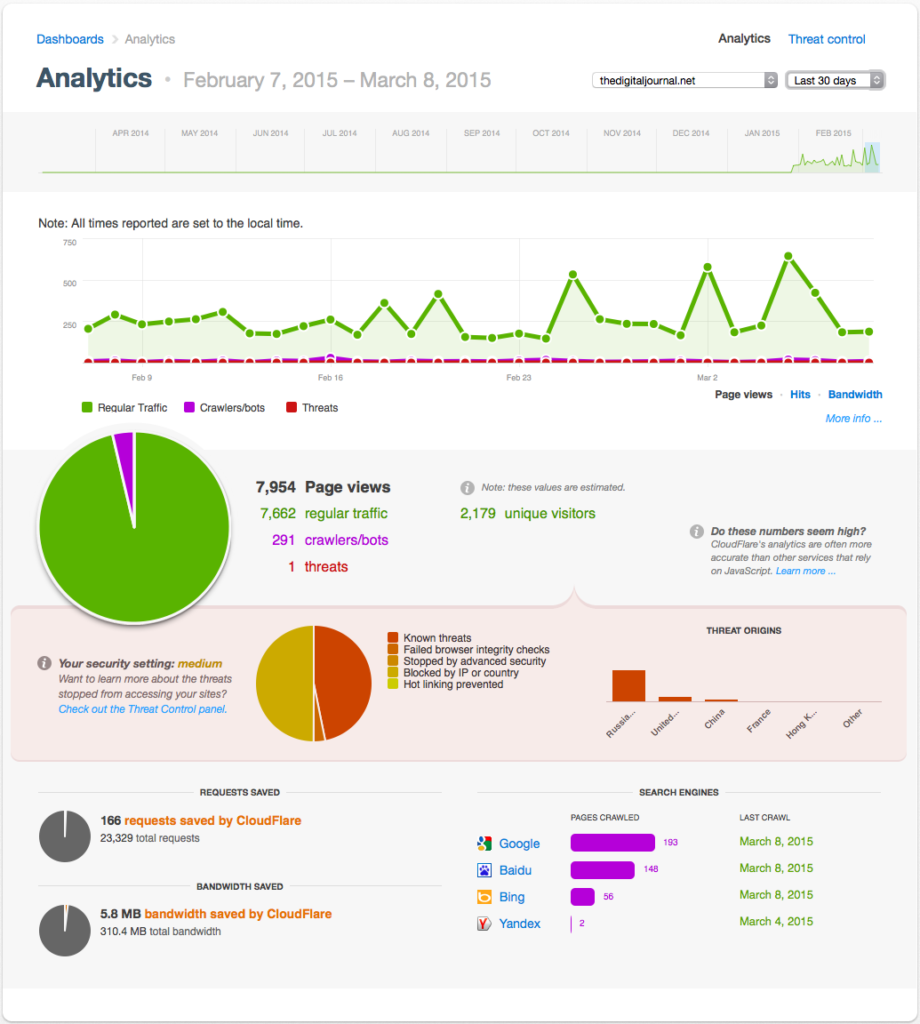
The post Cloudflare – Boosting site performance with Cloud CDN appeared first on The Digital Journal.
]]>